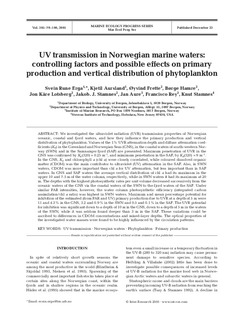| dc.description.abstract | We investigated the ultraviolet radiation (UVR) transmission properties of Norwegian
oceanic, coastal and fjord waters, and how they influence the primary production and vertical
distribution of phytoplankton. Values of the 1% UVR attenuation depth and diffuse attenuation coefficients
(Kd) in the Greenland and Norwegian Seas (GNS), in the coastal waters of south-western Norway
(SWN) and in the Samnanger fjord (SAF) are presented. Maximum penetration of UVR in the
GNS was confirmed by Kd(320) = 0.25 m–1, and mimimum penetration in the SAF, by Kd(320) = 9 m–1.
In the GNS, Kd and chlorophyll a (chl a) were closely correlated, while coloured dissolved organic
matter (CDOM) was the main contributor to ultraviolet (UV) attenuation in the SAF. Also, in SWN
waters, CDOM was more important than chl a for UV attenuation, but less important than in SAF
waters. In GNS and SAF waters the average vertical distribution of chl a had its maximum in the
upper 10 and 7.5 m of the water column, respectively, while in SWN waters it had its maximum at 20
m. The depths with the highest photosynthetic rates per unit volume decreased successively from the
oceanic waters of the GNS via the coastal waters of the SWN to the fjord waters of the SAF. Under
similar PAR intensities, however, the water column photosynthetic efficiency (integrated carbon
assimilation/chl a ratio) was highest in SWN waters. Maximum and mean percentage potential for
inhibition of the estimated (from PAR and UV) primary production due to UVR at a depth of 5 m were
11 and 4.3% in the GNS, 3.2 and 0.9% in the SWN and 0.5 and 0.1% in the SAF. The UVR potential
for inhibition was significant down to a depth of 10 m in the GNS, down to a depth of 5 m in the waters
of the SWN, while it was seldom found deeper than 3 m in the SAF. These variations could be
ascribed to differences in CDOM concentrations and mixed-layer depths. The optical properties of
the investigated water masses were found to be highly influenced by the circulation patterns. | no_NO |
